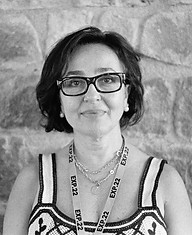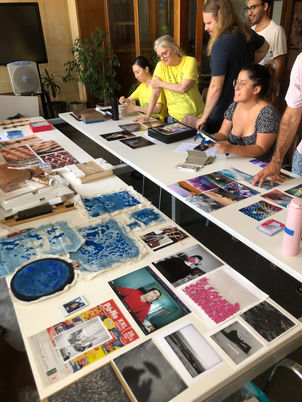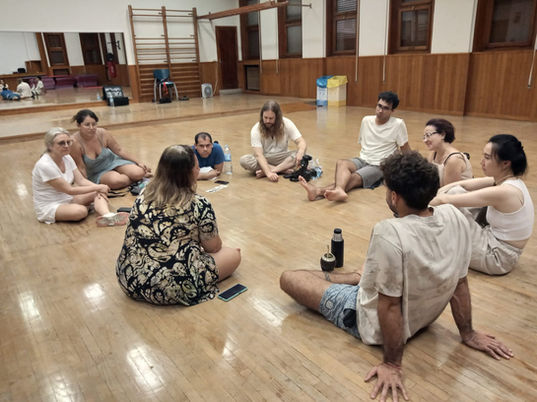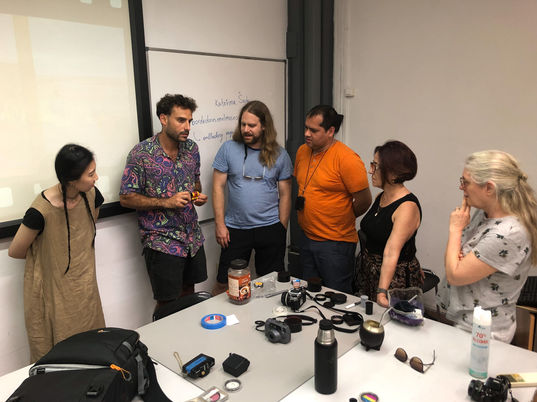From December 1 to December 31, 2022, we opened the call for applications to anyone interested in joining the First International Residency of Experimentation IEFC-EXP. The residency took place during the 10 days leading up to the Experimental Photo Festival, from July 19 to July 23, 2023.
During their stay, each resident had a day to conduct a theoretical-practical workshop where they explained an experimental technique to the rest of the group. The residency aimed to create a small, horizontal community of collaborative learning where eight different techniques were worked on, rather than a space where each participant worked individually on their personal projects. The residency concluded with a collective exhibition showcasing the learning process of the different techniques, rather than the results, which was displayed on the ground floor of the Institut d'Estudis Fotogràfics de Catalunya during the Experimental Photo Festival in Barcelona.
Directed and Coordinated
by Célica Véliz
Artists
Ana Mundim - Brasil
Dany Vigil - El Salvador - República Checa
Ezequiel Lovrovich - Argentina
Gonzalo Rostán - Uruguay
Gül Cevikoglu - Turquía
Lexy Liangzi Xiao - China - Noruega
Lucía Calabrino - Argentina
Scarlet Galicia García - México
Stephen Takacs - Estados Unidos

Workshops
Ana Mundim - Fotocoregrafías: imágenes para mover y ser movidas
In the workshop, we explored the concept of photochoreography, an innovative technique that blends photography and dance. We started with a theoretical introduction to the concept, including examples of original works and the difference between improvisation in dance and photography. We discussed how photography can be an act of improvisation and real-time composition, similar to dance. We focused on the perception of the moving body and how to capture it photographically. Participants engaged in pair exercises, using handmade filters to create real-time edits.


Dany Vigil - Stitches on paper: introduction to photography embroidery
In the workshop, in addition to getting to know each other and sharing our experiences and backgrounds, we gave a brief introduction to vernacular photography and artisanal techniques. We explored the history of embroidery, its relationship with photography, and contemporary examples. In the practical part, we introduced the materials and demonstrated the process of embroidery on photographs. Participants worked on their projects, with additional time dedicated to supervision and the development of their ideas.
Ezequiel Lovrovich - Cianotipia textil y bordado como herramientas para entender la fotografía
In the workshop, we began with a section on Peirce's semiotics, differentiating signs into symbols, icons, and indices, and how our brain interprets what we see. We explored Filiberto Menna's ideas on the tension between surface and representation. In the practical part, we used cyanotype chemicals to print portraits on fabric. After revealing the prints, we exchanged works to experiment with new interpretations. We combined the images into a collective tapestry and embroidered over the white stains, altering the original perception. The collective embroidery encouraged communication and exchange. Finally, we discussed the tapestry as a symbol of our shared experience and how creative decisions shaped the final message.


Gonzalo Rostan - Habitar los sueños: Filmsoups y revelaciones
During the workshop, we covered both theoretical and practical aspects of advanced photographic techniques. In the theoretical section, we explored creating images through double exposure, using Redscale and EBS films, and Filmsoups techniques, including recipes and technical considerations. In the practical part, participants created EBS rolls and conducted portrait sessions using filters, EBS rolls, swap techniques, and double exposures. Additionally, they experimented with instant Filmsoups and performed manual color development using the C41 process.
Gül Cevikoglu - The Terrains of Barcelona: A Chromatography Soil Portraits
In the workshop, we introduced Soil Chromatography, covering its history, approaches from other artists, and technical characteristics. We demonstrated how to combine Cyanotype techniques with Soil Chromatography and showcased the resulting images and prints.


Lexy Xiao Liangzi - Chromoskedasic painting, Sabattier and sliver mirroring
Workshop on Chromoskedasic Painting, a technique for creating colorful images on black-and-white photographic paper using light scattering principles. The process, originally developed by Dominic Man-Kit Lam in the 1990s, uses activators and stabilizers to produce colors through the Mie scattering of silver particles. The workshop included both theoretical and practical components, allowing participants to learn and experiment with the technique.
Lucía Calabrino - Imagen y espacio
In the workshop, we explored textile intervention through techniques like embroidery and textile text, emphasizing their role as a significant complement to the image, rather than just filler. Each three-dimensional line in the embroidery enhances the form, thickness, color, and materiality of the image. The embroidered text broadens expressive possibilities, aiming for a harmonious integration where word and image complement each other without explaining one another. Air embroidery, using a frame and water-soluble interfacing, adds a volumetric dimension by incorporating space into the expressive play. We emphasized the importance of selecting appropriate stitches and techniques, such as those for paper and textile writing, to enhance the work without overwhelming it.


Scarlet Galicia García - La fotografía, el movimiento y la realidad virtual
During the workshop, we explored the Artivive app to create a photographic sequence that transforms into animation, bridging the gap between static images and photographic material. We discussed the relationship between movement and photography and how virtual reality can enhance this connection. In the practical part, participants created a photographic series with the intention of turning it into an animation. They selected one piece from the series, printed it, and uploaded both the photograph and the associated animation to the platform. This process allowed for a deeper understanding of how to tell stories through the integration of physical and virtual elements.
Stephen Takacs - DIY 8x10 Polaroids aka RA-4 Reversal
During this workshop, historical and contemporary examples of direct positive analog photographic images were presented. We demonstrated how to create 8" x 10" color photographs using the RA-4 Reversal Process. An 8" x 10" camera was used to show image exposure, and the RA-4 process was combined with the photogram technique. Participants were guided to experience this process firsthand. There was particular interest in collaborating with other artists who were building or modifying their own cameras, exploring how to adapt the process to different camera systems.

Exposición
Collective Exhibitions of Processes
International Residency of Experimentation EXP-IEFC
The residence seeks to generate a small horizontal community of collaborative learning, where each one, every day, teaches in a theoretical-practical workshop, an experimental technique and their way of working to their fellow residents, emphasizing the mixture of techniques, in the message and collaborative work. A community where embroidery, large-format instant photography, family archives, sewing, cyanotypes, chromoskedasic painting, slide projection, virtual reality, images created with earth, and photochoreography can coexist and discuss.As we have ten days to work, we did not want to make an exhibition of completed works or finished projects, we understand that this is a starting point for learning, research and collaboration. That is why what you are seeing here is a work-in-progress exhibition, taking Paul Valéry and his First Lecture from 1937 as a reference, in which he proposed the term poïétique to refer to “the study, not of the finished work, but of its production” and conditions of realization”.



























